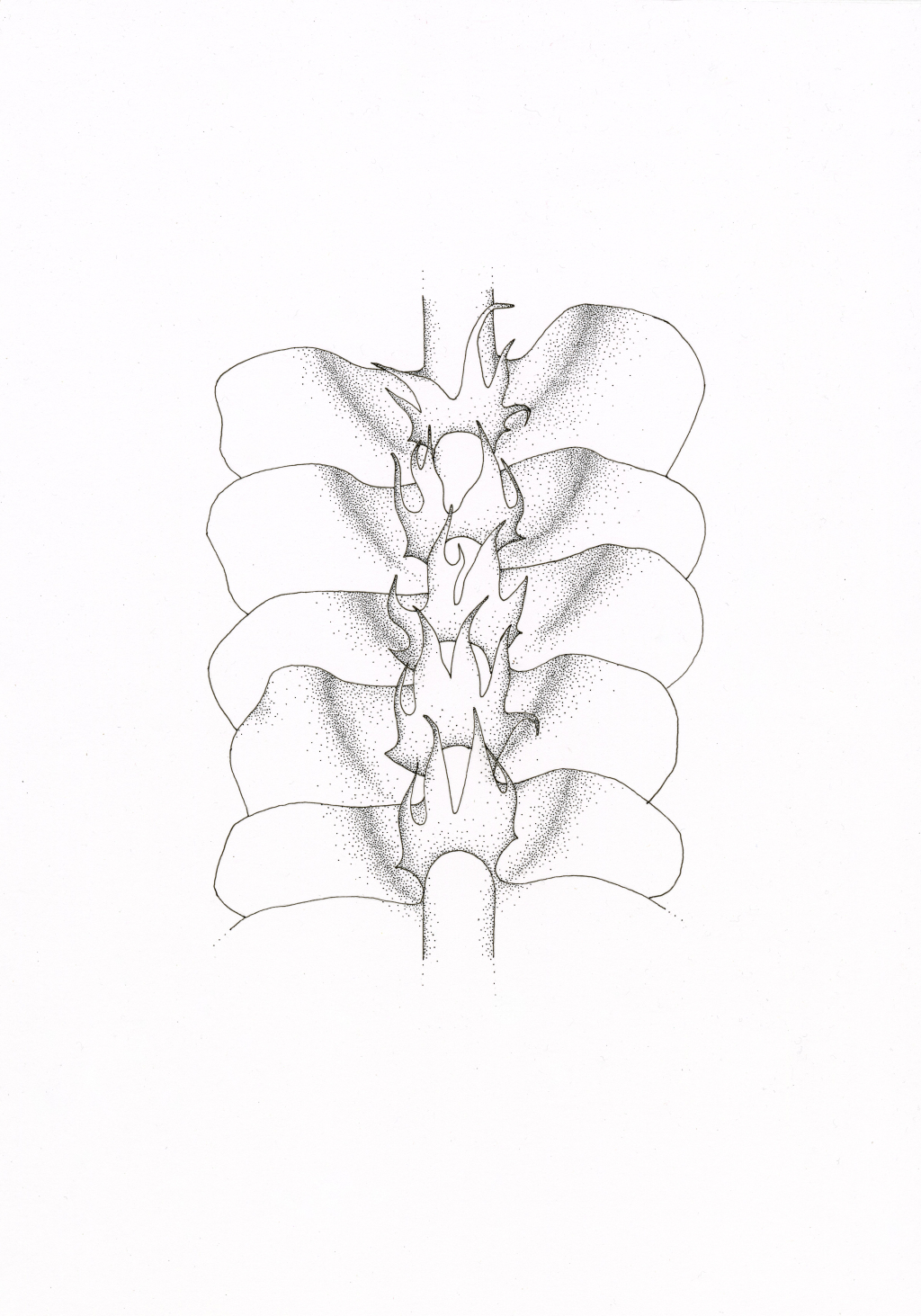Lophocoleaceae
Epiphytic, lithophytic or terrestrial, dioicous or rarely autoicous or paroicous (not in Victoria), light-green, yellow-green, olive-green to brownish. Asexual reproduction by caducous leaves (not in Victoria), caducous leaf lobes or teeth, or by gemmae produced on leaf margins and shoot apices. Stems creeping or erect (not in Victoria), rarely differentiated into creeping microphyllous axes and erect axes with normal leaves, irregularly branched; branches emerging from main stem near an unmodified lateral leaf or underleaf and with a collar of tissue at base, or emerging from below a narrowed lateral leaf or beside a narrowed underleaf (not in Victoria) and without a collar at base, with two ranks of lateral leaves and usually a third rank of underleaves, rarely underleaves caducous near stem base; collar when present unlobed ring of tissue. Lateral leaves oblong, rectangular, ovate, obovate (not in Victoria) or orbicular in outline, unlobed, retuse or 2–4-lobed, succubous to transverse, attached at dorsal centre of stem and leaving no leaf free strip of cells along stem to attached to side of stem and leaving a broad dorsal leaf-free strip of cells, alternate to opposite, imbricate to distant, entire or dentate, sometimes with numerous teeth, concave or convex adaxially, broadly attached to stem, when moist spreading parallel to substrate, with apices pointing toward substrate or away from substrate, rarely multistratose (not in Victoria). Underleaves usually smaller than lateral leaves, rarely larger than lateral leaves (not in Victoria), narrower or wider than stem, usually 2–4 lobed and often with 2 main central lobes and smaller additional lobes or teeth, one to each pair of lateral leaves, sometimes unlobed and reniform with numerous teeth, or triangular to lanceolate, rarely entire (not in Victoria), fused to both nearest lateral leaves, fused to one lateral leaf or completely free from lateral leaves, distant to imbricate, concave, plane or convex when viewed from below. Leaf cells quadrate, circular, elliptic or polygonal, smooth or bearing 1–several cell spine-like projections, thin- or firm-walled, with or without distinct trigones, with 1–45 oil bodies; oil bodies ovoid, fusiform, obloid or ellipsoid, homogenous or granular to botryoidal, colourless, greyish, brownish or rarely blue (not in Victoria). Rhizoids in fascicles from underleaf bases, without internal peg-like thickenings, hyaline or brown. Androecia on main leafy axes or on short branches emerging from stem near lateral leaves, with multiple ventricose bracts, each usually with 1 antheridium. Sporophyte terminal on elongate leafy axes or on short branches emerging from stem near lateral leaves or underleaves, developing within a perianth; perianth urceolate, obovoid, ellipsoid, obloid or cylindric, terete to trigonous and terminating in three bifid or undivided lobes or rarely laterally compressed toward mouth and bilabiate, with entire, toothed, laciniate or ciliate mouth; capsule ovoid, obloid, ellipsoid or cylindric, 2–8-stratose, dehiscing by 4 valves; elaters bispiral, rarely 3-spiral (not in Victoria); spores granulate, papillose, verrucose or vermiculate.
Around 18 genera and 400 species in moist regions of the world, but exact numbers uncertain due to uncertainty in species limits due to high phenotypic plasticity and unresolved phylogentic relationships among described genera (Schuster 2021; see below); around six genera and 25 species in Victoria.
Lophocoleaceae form some of the most abundant terrestrial and lithophytic liverworts in Victoria, largely due to the widespread occurrence and the abundance of Chiloscyphus semiteres (Lehm.) Lehm & Lindenb., which is probably Victoria’s most widespread and common liverwort species, and Heteroscyphus fissistipus (Hook.f. & Taylor) Schiffn. that is often encountered along streams in wet forests. The Lophocoleaceae are distinguished from other Victorian leafy liverworts by a combination of the presence of underleaves, that are of a different form from the lateral leaves and are often fused to them, lateral leaves that are succubously inserted, rhizoids in fascicles at the underleaf bases, and by the presence of a perianth and absence of a marsupium around the developing sporophyte.
The Lophocoleaceae has previously been included in the Geocalycaceae. However, Geocalycaceae differs primarily by the development of a marsupium (derived from stem tissue) around the sporophyte and are not closely related to Lophocoleaceae (Hentschel et al. 2006). Instead, the Lophocoleaceae is most closely related to the Brevianthaceae, originally described to accommodate the distinctive genus Brevianthus J.J.Engel & R.M.Schust. (Patzak et al. 2016). The boundaries between these two families are unclear as many genera of Lophocoleaceae have yet to included in DNA phylogenies and some species that have been previously placed in the Lophocoleaceae genus Heteroscyphus Schiffn. (i.e. Tetracymbaliella (Grolle) J.J.Engel & R.M.Schust. species), have been shown to be more closely related to Brevianthus than to Lophocoleaceae and have accordingly been transferred to Brevianthaceae, obscuring the morphological boundaries between the two families (Söderström et al. 2013; Patzak et al. 2016). The boundaries of Lophocoleaceae genera also remain tentative until a more comprehensive understandings of phylogenetic relationships in the family can be achieved with increased taxon sampling, especially of unsampled genera (Patzak et al. 2016; also see genus profiles).
Hentschel, J., Wilson, R., Burghardt, M., Zündorf, H.-J., Schneider, H. & Heinrichs, J. (2006). Reinstatement of Lophocoleaceae (Jungermanniopsida) based on chloroplast gene rbcL data: exploring the importance of female involucres for the systematics of Jungermanniales. Plant Systematics and Evolution 258: 211–226.
Patzak, S.D.F., Renner, M.A.M., Schäfer-Verwimp, A., Feldberg, K., Heslewood, M.M., Peralta, D.F., de Souza, A.M., Schneider, H. & Heinrichs, J. (2016). A phylogeny of Lophocoleaceae-Plagiochilaceae-Brevianthaceae and a revised classification of Plagiochilaceae. Organisms Diversity & Evolution 16: 481–495.
Schuster, R.M. (2021). Austral Hepaticae Part III. Nova Hedwigia Beiheft 120. Cramer in der Gebrüder Borntraeger Verlagsbuchbehandlung: Stuttgart.
Söderström, L., Crandall-Stotler, B., Stotler, R.E., Váňa, J., Hagborg, A. & Von Konrat, M. (2013). Notes on early land plants today. 36. Generic treatment of Lophocoleaceae (Marchantiophyta). Phytotaxa 97: 36–43.
 Spinning
Spinning